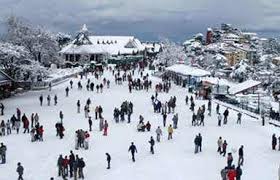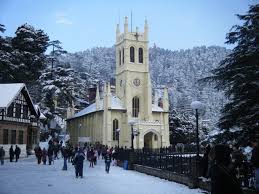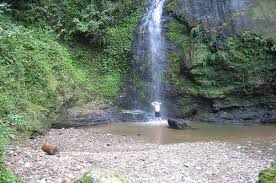|
Shimla (also spelt as 'Simla')
derives its name from goddess 'Shayamla Devi', which is another
manifestation of Goddess Kali. The capital of Himachal Pradesh
came into light when the British discovered it in 1819. Till then,
it was a part of the Nepalese kingdom. In 1864 Shimla was declared
as the summer capital of India. After Independence, Shimla became
the capital of Punjab and was later named the capital of Himachal
Pradesh. In 1903 a rail line was constructed between Kalka and
Shimla.
Shimla has been blessed with all the natural bounties, one can
think of. Dwelling on a panoramic location, the hilly town is
surrounded by green pastures and snow-capped peaks. The
spectacular cool hills accompanied by the structures made during
the colonial era create an aura, which is very different from
other hill stations.
Shimla's Seven Hill Attractions
The seven hills of Shimla are - Prospect Hill in Wes tern
Shimla, which has the temple of Kamna Devi; Summer Hill in Western
Shimla, which has the campus of the Himachal Pradesh University;
Observatory Hill in Western Shimla, which holds the estate of the
Indian Institute of Advanced Study; Invererarm in Western Shimla,
whose top has the State Museum; Bantony in central Shimla, which
has the Grand Hotel; Jakhoo in central Shimla, which is crowned by
the temple indicated to Lord Hanuman, and Elysium in north-western
Shimla, which holds Auckland House and Longwood and reaches out
towards the Bharari spur. tern
Shimla, which has the temple of Kamna Devi; Summer Hill in Western
Shimla, which has the campus of the Himachal Pradesh University;
Observatory Hill in Western Shimla, which holds the estate of the
Indian Institute of Advanced Study; Invererarm in Western Shimla,
whose top has the State Museum; Bantony in central Shimla, which
has the Grand Hotel; Jakhoo in central Shimla, which is crowned by
the temple indicated to Lord Hanuman, and Elysium in north-western
Shimla, which holds Auckland House and Longwood and reaches out
towards the Bharari spur.
Shimla's Malls
As the town of Shimla grew throu gh
the 19th century, its Mall steadily developed as the town's
commercial street and the hub of its social life. The road, which
some 5-km in length, starts in the west at the gates of he former
Viceregal Lodge , the present day Indian Institute of Advanced
Study and ends at Chhota Shimla or 'Small' Shimla, in the east. gh
the 19th century, its Mall steadily developed as the town's
commercial street and the hub of its social life. The road, which
some 5-km in length, starts in the west at the gates of he former
Viceregal Lodge , the present day Indian Institute of Advanced
Study and ends at Chhota Shimla or 'Small' Shimla, in the east.
The route has bends, as one would expect any hill road to have, ut
its nature essentially follows a wide sweeping curve along the
hills. The primary aspect is south facing and affords a view of
the valley below the town and of the foothills that reach out to
the plains from its habitation. In pockets, snatches of the
northern aspect spring up for a dramatic view and hold woods of
Pine and Himalayan Cedar - the majestic Deodar. This picture of
nature's bounty is framed by the distant snow ranges of the
Greater Himalaya.
Prime Attractions of Shimla
Annandale : Annandale, just 2-km below the Ridge in Shimla,
offers a picturesque piece of ground, charmingly adapted for
recreation in the days of the Raj. Today it affords a pleasant
change from the perpetual slopes above.
Chadwick Falls : -km beyond the Su mmer
Hill and 7-km west of the ridge from Shimla are the Chadwick
Falls, which was once the site of a 67-m aquatic spectacle. mmer
Hill and 7-km west of the ridge from Shimla are the Chadwick
Falls, which was once the site of a 67-m aquatic spectacle.
Chapslee : Containing the comfortable elegance of an English
country manor, Chapslee was originally built in 1835.
Christ Church And St Michael'S Cathedral : The most prominent
building on the Mall is the yellow Christ Church, reputed to be
the second oldest church in northern India. The silhouette of this
can be seen on the skyline for miles around. It was designed by
Colonel JT Boileau in 1844, but consecrated only after 1857. The
clock was donated by Colonel Dumbleton in 1860, and the porch
added in 1873.
Churdhar Sanctuary : The sanctuary got its name from the Chur
Peak, on the top of which sits a majestic status of Lord Shiva.
One is sure to come across a large number of multi-coloured and
agile Monals in the adjoining forests.
Gurkha Castles : The Gurkha castles in Solan, Sirmour,
Bilaspur and Shimla districts remind us of the life and time under
the Gurkha regime. While most of the structures built by the
Gurkhas have crumbled, the remaining few beckon tourists.
Hatkoti : Some 105-km east of Shimla, in Jubbal Tehsil on the
banks of the river Pabbar, lays the mysterious valley of stone
temples Hatkoti. Close by stands a small village by the name of
Parhaat.
Jakhu Temple : No visit to the state capital Shimla is
complete without visiting Jakhu Hill. This hill looms over Shimla
town and is the geographical nucleus. The Hanuman temple at the
top of Jakhu hill is the highest point in town.
|